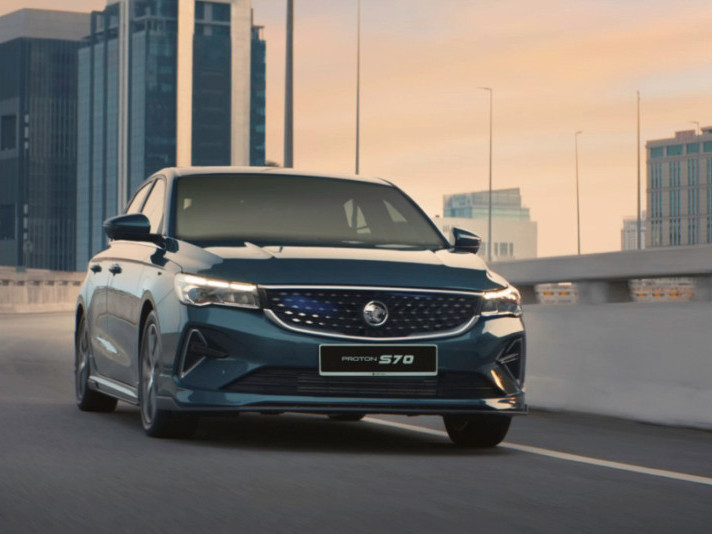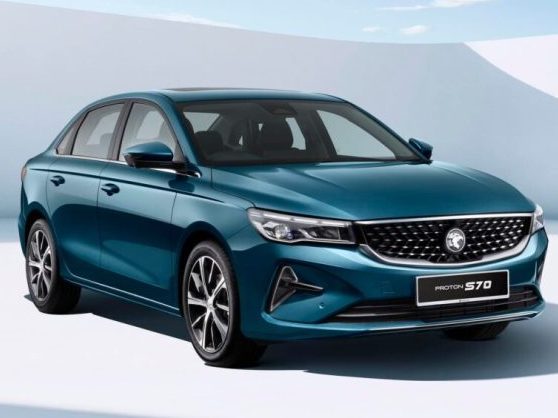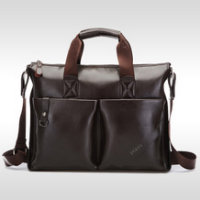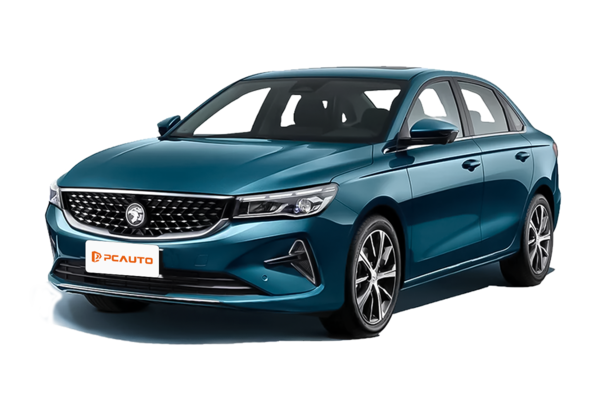Q
what is the s70 engine in proton?
The 1.5T three - cylinder turbocharged engine powering the Proton S70 is a collaborative effort between Proton and Geely, belonging to Geely's 1.5TD family (specifically the JLH - 3G15TD variant). This powerplant features direct fuel injection, generating a maximum power of 177 horsepower (130kW) and a peak torque of 255 Nm. It's paired with a 7 - speed wet dual - clutch transmission. You may already be familiar with this engine, which has been proven in models like the Proton X50 and X70. It's known for delivering strong torque at low revs, which makes it well - suited for Malaysian city driving conditions. Plus, it meets the Euro 5 emission standard. From a technical perspective, this engine comes packed with mainstream technologies such as a low - inertia turbocharger and dual variable valve timing (DVVT). We know that the three - cylinder configuration can sometimes make consumers somewhat wary about refinement. However, Proton has addressed this concern by incorporating a balance shaft and a hydraulic mounting system to optimize smoothness. It's also worth highlighting that Proton has significantly improved its powertrain competitiveness in recent years through technology sharing with Geely. This particular engine represents a marked improvement in terms of fuel efficiency and maintenance costs compared to the earlier CamPro series. We strongly recommend that owners stick to the official maintenance schedule and use the specified engine oil to keep the engine running at its best. For Malaysian users who prioritize fuel efficiency, the S70's 1.5T engine offers some practical advantages. According to official figures, it delivers a combined fuel consumption of 5.7L/100km, and it's also compatible with Ron95 petrol – which is always a plus.
Special Disclaimer: This content is published by users and does not represent the views or position of PCauto.
Related Q&A
Q
How much is S70 2024 in Malaysia?
Pricing details for the 2024 Volvo S70 haven't been officially announced yet, but looking at the current S60's price range (around RM250,000 to RM300,000) and the brand's recent pricing strategies, we can expect the S70 to start at roughly RM280,000, with higher-spec variants possibly approaching RM350,000. The new model is set to carry forward Volvo's family design language and will likely feature an upgraded plug-in hybrid system – the T8 Recharge version, for instance, might deliver over 400 horsepower combined. Standard tech should include the City Safety active safety suite and Pilot Assist semi-autonomous driving aids. It's worth noting that rivals like the BMW 3 Series and Mercedes-Benz C-Class have also rolled out mild-hybrid models lately. When comparing options, shoppers should pay attention to differences in hybrid tech approaches (like 48V mild hybrids versus plug-in hybrids) and after-sales warranty policies (some brands offer 5-year/unlimited mileage coverage). If you're interested, keep an eye on the upcoming Kuala Lumpur International Motor Show or reach out to authorized dealers directly to schedule a test drive – get hands-on with the Nordic luxury sedan's driving feel and signature features like those ergonomic seats.
Q
Is the Proton S70 fuel consumption?
As the latest four - door sedan launched by the Proton brand, the Proton S70's fuel economy performance meets the mainstream level of Class B sedans. The official combined fuel consumption data is 6.0 - 6.4 liters per 100 kilometers (the specific figure varies depending on the driving mode and road conditions). This result is quite reasonable for the power combination of a 1.5 - liter turbocharged engine and a 7 - speed dual - clutch transmission.
The actual fuel consumption is affected by driving habits. For example, it may rise to 7.5 - 8.0 liters in congested urban areas in Kuala Lumpur, while it can drop to around 5.5 liters during high - speed cruising. It is recommended that car owners optimize fuel consumption through regular maintenance (especially replacing the air filter and spark plugs), maintaining a reasonable tire pressure (210 - 230 kPa), and avoiding rapid acceleration.
It's worth noting that the fuel consumption data of competing models in the same class, such as the Honda City and Toyota Vios, also fall within a similar range. This reflects that the current small - displacement turbocharging technology has become the mainstream solution for balancing power and fuel consumption. For users who often drive long - distance, the S70's 40 - liter fuel tank, combined with this fuel - consumption level, can provide a cruising range of approximately 600 kilometers, which can fully meet the inter - city commuting needs on the Malay Peninsula.
Q
Does the Proton S70 have a sunroof?
The current model configurations of the Proton S70 do not come with a sunroof. This car focuses more on performance in terms of power, intelligent technology, and practicality. For example, it is equipped with a 1.5T turbocharged engine and a wide range of driving assistance systems. For Malaysian consumers, while a sunroof can enhance interior lighting and create a more open - feeling cabin, it may also increase the interior temperature in the tropical climate. That's why many local models prioritize optimizing air - conditioning efficiency and heat insulation performance.
If you particularly value the sunroof configuration, you can consider some high - end versions of other models in the same class, such as the Honda City or the Toyota Corolla Altis. However, you need to be aware of the maintenance costs of the sunroof and the potential rattling issues that may occur over long - term use.
The Proton S70 is more positioned towards family practicality and cost - effectiveness. Its standard - equipped LED headlights, digital dashboard, and Advanced Safety Assist system can already meet the daily needs of most users. It is recommended that you weigh the priority of configurations based on your actual usage scenarios.
Q
How heavy is the Proton S70?
The weight of the Proton S70 is approximately between 1,300 and 1,400 kilograms, specifically depending on the vehicle configuration and powertrain. As a four - door sedan under Proton, this car adopts a lightweight design and an efficient powertrain, ensuring good fuel economy and driving performance. For Malaysian consumers, the Proton S70 has a moderate weight. It not only guarantees stability during high - speed driving but also doesn't significantly increase fuel consumption, making it highly suitable for daily commuting and long - distance driving.
Moreover, the vehicle weight also has a certain impact on the suspension system and braking performance. The Proton S70 has been carefully tuned in this regard, offering a comfortable driving and riding experience and reliable braking effects.
If you're interested in more details of the Proton S70, such as engine performance or safety features, you can further learn about its 1.5 - liter turbocharged engine and a wealth of advanced safety technologies, which are the highlights of this model.
Q
How many cylinders in the S70?
As a classic model from the late 1990s to the early 2000s, the Volvo S70's engine configurations vary depending on the market and version. The most common one is the inline 5-cylinder engine (that is, 5 cylinders), such as the 2.4-liter or 2.5-liter turbocharged versions. This engine is well - known for its smoothness and durability, which is suitable for Malaysia's diverse road conditions. For Malaysian users, the inline 5-cylinder layout strikes a balance between power output and fuel economy. Meanwhile, Volvo's engine technology also emphasizes safety and environmental protection standards, meeting the local people's trust in European cars. If you're considering a used S70, it's recommended to check the engine maintenance records because the number of cylinders directly affects the complexity of repairs and the supply of spare parts. Special attention should be paid to the maintenance of the cooling system and ignition coils in Malaysia's humid climate. In addition, modern Volvo models generally use 4-cylinder engines or hybrid power, but the 5-cylinder design of the S70 remains a unique symbol in the hearts of car enthusiasts. Its sound and power characteristics were quite distinctive among cars of the same class back then.
Q
Is the Proton S70 Heavier Than the X50?
The weight of the Proton S70 is approximately between 1,325 kg and 1,345 kg, depending on different versions. Meanwhile, the Proton X50 weighs between 1,300 kg and 1,330 kg. There isn't a significant difference in weight between the two, but as a three - box sedan, the S70's body structure focuses more on high - speed stability, so it's slightly heavier. In contrast, as a compact SUV, the X50's body design leans more towards flexibility and passability, and its weight distribution is also different.
In the Malaysian market, both models adopt Proton's latest technological platforms. The S70 is built on the BMA platform, while the X50 shares the platform with the Geely Binyue. Both cars have done well in lightweight design, ensuring body rigidity while also taking fuel economy into account.
For consumers, when making a choice, besides the weight, they can also consider space requirements, driving habits, and usage scenarios. For example, the S70 is more suitable for long - distance driving, while the X50 is better for urban commuting and occasional light off - road driving. Both cars demonstrate Proton's advantages in local production and tuning, and can well adapt to the road conditions and climate in Malaysia.
Q
How many seats does the Proton S70 have?
The Proton S70 is a five-seater sedan with a standard four-door, three-box design, offering Malaysian consumers a comfortable seating space and a practical family car experience. As the latest model under the Proton brand, the S70 focuses on ergonomics in its seat design. The front seats provide excellent support, while the rear seats balance legroom and seating comfort, making it suitable for long-distance travel or daily commuting. The trunk of this car also has a relatively large capacity, which can meet the storage needs of family trips.
The Proton S70 is equipped with a 1.5-liter turbocharged engine, delivering a well-balanced performance. Meanwhile, it comes with a rich array of technological features, such as an advanced infotainment system and driving assistance functions, further enhancing driving convenience and safety.
For Malaysian consumers, the Proton S70 is an outstanding choice in terms of cost-effectiveness, especially for family users who value practicality and comfort. Its localized design and manufacturing also ensure the convenience of after-sales service.
Q
How much torque does a Proton S70 have?
As the latest sedan model of the Proton brand, the Proton S70 is equipped with a 1.5-liter turbocharged four-cylinder engine. Its maximum torque output reaches 226 Nm and is continuously delivered within a wide speed range of 1,500 to 4,000 rpm. This tuning is particularly suitable for the common scenarios of urban congestion and highway overtaking in Malaysia. This torque data stands out among 1.5T models in the same class. Paired with a simulated 7-speed CVT transmission, it can balance smoothness and fuel economy.
It's worth noting that the low-speed and high-torque characteristics of the turbocharged engine give the S70 an edge when starting and climbing hills. The width of the torque peak platform also means that you don't need to downshift frequently to get sufficient power in daily driving. For Malaysian consumers, this kind of power configuration can not only meet the needs of family cars but also provide enough driving confidence during occasional long-distance trips. At the same time, it meets the local market's emphasis on fuel efficiency.
If you want to further understand the impact of torque on the driving experience, you can observe the vehicle's performance on mountain roads such as Genting Highlands. Ample torque can significantly reduce the power loss when climbing hills.
Q
Is the Proton S70 turbo?
Yes, the Proton S70 is equipped with a 1.5-liter turbocharged engine. This engine can deliver 150 horsepower and 226 Nm of torque. Paired with a 7-speed dual-clutch transmission, it offers decent power performance and fuel economy. As a four-door sedan under the brand, the Proton S70 inherits the technological and design advancements of Proton in recent years, especially in the powertrain. The application of turbocharging technology makes it more competitive among models in the same class. The advantage of the turbocharged engine lies in its ability to provide stronger torque at low speeds, which is suitable for the frequent stop-and-go traffic conditions in Malaysian cities. Meanwhile, it can also maintain good power reserve during high-speed driving. For consumers who focus on power performance, the turbocharged engine of the Proton S70 is a worthy option to consider. Moreover, Proton's local service network can also provide convenient after-sales support for car owners. If you're interested in turbocharging technology, you can also learn about its working principle and the precautions for daily maintenance to ensure the vehicle stays in good condition for a long time.
Q
Is the Proton S70 a hybrid?
The Proton S70 isn't a hybrid model. It's a traditional four-door sedan powered by fuel. It's equipped with a 1.5-liter turbocharged gasoline engine and paired with a CVT transmission. It belongs to the new sedan models under the Proton brand. At present, Proton's hybrid technology is mainly applied to SUV models like the X90, which uses a 48V mild-hybrid electric vehicle (MHEV) system. As a sedan focusing on economy, practicality and sporty design, the S70 still relies on fuel power.
For Malaysian consumers, if they're considering fuel-saving and eco-friendly options, they can keep an eye on Proton's potential new-energy models in the future, such as the rumored all-electric Persona or Iriz. However, at this stage, the S70 is more suitable for users who pursue power performance and cost-effectiveness.
Hybrid technology is gradually becoming popular in the Malaysian market. Japanese models like the Toyota Corolla Cross Hybrid or the Honda City RS e:HEV also offer more choices. Nevertheless, the advantage of the Proton S70 lies in the high cost-effectiveness of parts and the convenience of after-sales service of this local brand. It's suitable for family users with limited budgets who need large space and rich configurations.
Popular Cars
Model Year
Car Compare
Car Photo
Latest Q&A
Q
What vehicle has the highest horsepower?
The most powerful production car in the world right now is the Bugatti Chiron Super Sport 300+. Its monstrous 8.0-liter quad-turbo W16 engine churns out an insane 1,600 horsepower, with a top speed of 490 km/h - absolute peak internal combustion engineering.
That said, electric hypercars are starting to push boundaries too. Take the Rimac Nevera: 1,914 hp from its four-motor setup proves EVs have serious performance potential.
For us car enthusiasts, horsepower is just one piece of the puzzle. Things like torque delivery, transmission tuning, weight distribution, and aero make all the difference in real-world driving. Some high-performance SUVs might not match supercars on paper, but clever AWD systems and well-sorted suspension can deliver just as much excitement.
Truth be told, excessive power means little in daily driving. Reliability, fuel efficiency, and safety tech matter far more to most buyers. At the end of the day, a well-balanced package always wins.
Q
How fast is 3600 RPM in mph?
Converting engine RPM directly to speed in mph requires factoring in transmission gear ratios, final drive ratio, and tire size – the numbers vary wildly between models. For example, at 3,600 RPM in 5th gear, your average sedan might cruise at 75-85 mph, while a performance car in lower gears could be doing just 40-50 mph at the same revs. The magic lies in the gear reduction setup and tire circumference. Generally, higher gears mean more speed per RPM, which is exactly why upshifting saves fuel and cuts noise during highway driving.
Word to the wise: most speedos and tachos show slightly optimistic numbers by design. If you need dead-accurate figures, check your owner's manual for gear ratios or plug in an OBD scanner. And here's a pro tip – keeping your revs in check isn't just kinder to your wallet at the pump, it'll help your engine go the distance too.
Q
What does 3000 RPM mean?
3000 RPM refers to the engine rotating at 3000 revolutions per minute, which is one of the important parameters for measuring the working status of the engine, usually displayed through the tachometer on the dashboard. When the engine is at 3000 RPM, it indicates that it is running at a moderate load, which is common in daily driving, such as cruising at a steady speed on highways or accelerating uphill. Different speed ranges can affect the performance and fuel efficiency of the engine. Generally speaking, lower speeds are more fuel-efficient but have weaker power, while higher speeds can provide stronger power but increase fuel consumption. For turbocharged engines, around 3000 RPM may be the range where the turbo is fully engaged, and the power output will be more abundant at this time. Understanding the engine speed helps to better grasp the timing of gear shifts. For manual transmission models, shifting between 2500 and 3000 RPM can balance power and fuel economy. In addition, maintaining high engine speed for a long time may increase engine wear, so it is recommended to control the speed reasonably according to the actual road conditions.
Q
What is the maximum RPM of a turbocharger?
The maximum speed of a turbocharger is usually between 100000 and 300000 revolutions per minute, depending on the design, size, and application scenario. High performance car models may have a turbocharger speed close to or even exceeding 300000 revolutions per minute, while ordinary family cars have a relatively lower turbocharger speed. The turbine speed is affected by various factors, including exhaust gas pressure, bearing type (traditional floating bearings or more efficient ball bearings), and the efficiency of the cooling system. Excessive speed may cause damage to the turbine blades, so modern turbochargers are equipped with pressure relief valves and electronic control systems to protect their safe operation. The significance of understanding turbine speed for daily driving lies in the fact that high-speed turbines can respond faster to throttle commands, reduce turbo lag, and feel smoother especially during start-up and acceleration. However, this also puts higher demands on lubrication and cooling systems, and regular replacement of high-quality oil and coolant is crucial for turbine life. In addition, the maintenance cost of a turbocharger is usually higher than that of a naturally aspirated engine, but proper use and maintenance can significantly extend its service life. For example, avoiding sudden acceleration after starting a cold car, and idling the engine for a while before turning off after a long drive can effectively protect the turbocharger components.
Q
Is 400Nm torque good?
A torque of 400Nm is already very abundant for daily driving, providing strong acceleration and good climbing ability, especially when overtaking at high speeds or carrying heavy loads. The torque of most family cars or city SUVs is usually between 200Nm and 350Nm, so 400Nm is already a relatively high level, suitable for drivers who pursue power performance. The magnitude of torque directly affects the vehicle's starting and acceleration performance. Higher torque means that the engine can output greater power at lower speeds, which not only enhances the driving experience but also reduces the need for frequent gear shifts. For diesel vehicles, a torque of 400Nm is more common because diesel engines typically focus on low-speed, high torque output characteristics. It should be noted that torque is only a part of measuring power, and vehicle performance needs to be comprehensively evaluated based on factors such as horsepower, gearbox matching, and vehicle weight. If you often drive long distances or need to tow heavy objects, a torque of 400Nm would be a good choice, but if it is purely for city commuting, such torque may be slightly excessive and instead increase fuel consumption.
View MoreRelated News

With a budget of 90k, should I choose the Proton S70 or the Honda City?
JamesDec 23, 2025

Proton S70 MC may be equipped with a four-cylinder engine, and the price will be reduced.
MichaelDec 17, 2025

Proton S70 Interior Revealed: More Advanced Technology Features
MichaelJul 2, 2025

Proton S70 vs Honda City: The New Segment Leader?
LienJun 5, 2025

Proton S70 Price Revealed: Complete Buying Guide for Your Best Deal
RobertApr 9, 2025
View More
















Pros
Cons